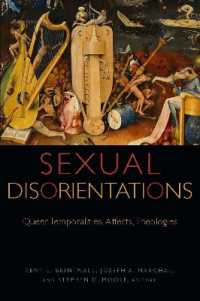- ホーム
- > 洋書
- > 英文書
- > History / World
Full Description
On February 27, 1973, a group of roughly 300 armed Indigenous men, women, and children seized the tiny hamlet of Wounded Knee, South Dakota, at gunpoint, took hostages, barricaded themselves in the hilltop church, and raised an upside-down American flag. Taking place at the site of the infamous massacre in 1890, the highly symbolic confrontation spearheaded by the American Indian Movement (AIM) ultimately evolved into a prolonged, seventy-one-day armed standoff between law enforcement officers and modern-day Indigenous warriors. Among these warriors were Vietnam War veterans armed with Vietnam-era equipment and weaponry. By organizing in defense of the newly proclaimed Independent Oglala Nation, the AIM activists at Wounded Knee linked their nationalist quest for sovereignty and self-determination with a warrior masculinity they constructed from a mix of Indigenous cultures and contemporary cultural elements, including the Black civil rights movement, the counterculture of the 1960s and early 1970s, and the antiwar movement.As Matthias AndrÉ Voight shows, the takeover of Wounded Knee was only one moment among many in the complex interplay between protest activism, gender, race, and identity within AIM. While AIM is widely recognized for its militancy and nationalism, Reinventing the Warrior is the first major study to examine the gendered transformation of Indigenous men within the Red Power movement and the United States more generally. AIM activists came to regard themselves, like their ancestors before them, as warriors fighting for their people, their lands, and their rights. They sought to remasculinize their Indigenous identity in order to confront hegemonic masculinities—and, by implication, colonialism itself. By becoming "more manly," Indigenous men challenged the disempowering nature of white supremacy.
Voigt traces the story of the reinvention of Indigenous warriorhood from 1968 to the takeover of Wounded Knee in 1973 and beyond. His trailblazing work explores why and how Indigenous men refashioned themselves as modern-day warriors in their anticolonial nation-building endeavor, thereby remaking both self and society.
Contents
Acknowledgments
A Note on Terminology
Abbreviations
Introduction
1. Indigenous Men and Peoplehood under US Colonial Domination
2. From Powerlessness to Protest: Reinventing Indigenous Men in AIM, 1968-1972
3. "We Became Warriors Again": Recasting Race, Gender and Nation, 1970-1973
4. Warriors for a Nation at Wounded Knee, 1973
5. Reinventing Warriorhood and Nationalist Struggle after 1973
Conclusion
Notes
Bibliography
Index








